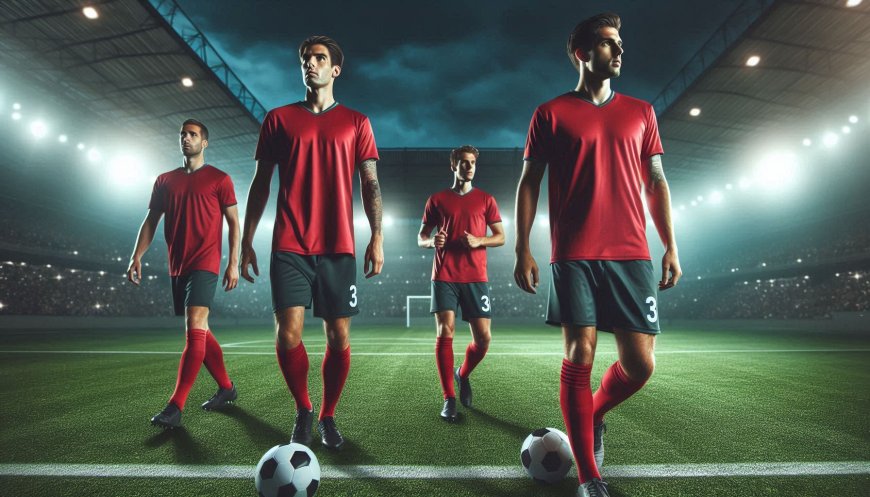The Power of Red: How Color Can Influence Victory on the Football Field
Explore how the color red can influence performance and victory on the football field, highlighting its psychological impact on players, fans, and competition.

As the team prepared to take the field, their bright red jerseys gleamed under the stadium lights. There was something about wearing red—it wasn’t just the color of their uniforms, it was the color of fire, of passion, of victory. The players felt it. The crowd felt it. And as their opponents lined up, there was an unmistakable shift in energy. Could it really be the color that made the difference?
Sports scientists have long been intrigued by the link between team uniforms and performance, and red, in particular, has captured their attention. On the surface, it seems like a simple matter of choice—teams wear colors for branding or tradition. But beneath the vibrant hues lies a deeper psychological and physiological influence, one that might just give red-wearing teams an edge on the field.
The Psychology of Power
Color psychology reveals that red isn’t just a shade; it’s an emotion. Across cultures, red is linked with dominance, aggression, and power. These associations can play a subtle yet powerful role in competitive settings. For football players, donning red can create a psychological boost. With red on their backs, players might feel a surge of confidence, as if they’re embodying the aggression and determination that the color signifies. It’s like wearing an invisible layer of armor—strengthening their mindset, helping them approach the game with more assertiveness and focus.
But the impact of red isn’t limited to the players wearing it. For the opposing team, seeing a squad decked out in bold, fiery red can trigger a subconscious reaction. Studies suggest that red can evoke feelings of intimidation or even caution. Opponents might be more hesitant, more defensive, sensing an increased challenge even before the game begins. It’s as if the red team carries an aura of invincibility, one that lingers in the minds of those who stand in their way.
The Numbers Don’t Lie
The history of football tells a compelling story. Some of the world’s most iconic football clubs—think Manchester United, Liverpool, and Bayern Munich—proudly wear red. And they win. A lot. This has led researchers to dig into the numbers, analyzing whether there’s a correlation between wearing red and success on the field. Interestingly, studies have shown that teams in red often win more games, sparking debates about whether the color itself plays a role in their dominance.
While it’s important to note that red alone doesn’t score goals or make tackles, the pattern is too striking to ignore. Some believe the color provides an unspoken advantage—an edge that might influence both individual player performance and team cohesion. It’s not just about the skill or strategy anymore; the color seems to amplify the mental game, tipping the balance in favor of those who wear it.
The Physiology of Red
Beyond psychology, there’s another layer to red’s influence—physiology. The sight of red can stimulate adrenaline, quickening the heartbeat and enhancing focus. For players, this boost in alertness and energy might translate into sharper reactions and more aggressive play. Red becomes more than a color—it’s a catalyst, encouraging players to tap into their full potential and play with heightened intensity.
On the other side, the team facing the red uniforms may experience subtle changes in their own physiology. The association of red with danger or threat could cause a rise in anxiety or hesitation, affecting decision-making and performance. A mistimed tackle here, a miscalculated pass there—all adding up to a potential advantage for the red team.
Luck, Culture, and Tradition
In some parts of the world, red is also a symbol of luck and fortune. Teams from cultures that view red as auspicious may feel an additional psychological boost when stepping onto the field in red kits. This layer of cultural meaning adds depth to the potential impact of color, further blending emotion, tradition, and performance.
However, it’s not always a perfect science. Not every team in red wins every game, and not every footballer feels invincible in the color. But the trend suggests there’s something special about the hue—something that goes beyond mere aesthetics.
More Than Just a Color
As the final whistle blew and the team in red celebrated their victory, it was easy to wonder whether their color had played a part. Sure, it was their skill, teamwork, and strategy that had secured the win, but the red jerseys? They were part of the story too. A silent, powerful influence that had accompanied them throughout the match.
The relationship between color and performance in sports remains a fascinating intersection of psychology, physiology, and tradition. While more research is needed to uncover the full extent of red’s power, one thing is clear: when it comes to football, sometimes it’s not just about how you play the game—it’s about what you wear while playing it.
Red might not win the game on its own, but in the high-stakes world of competition, every advantage counts. And if wearing red makes a team feel a little stronger, a little bolder, and just a little more unstoppable—well, that might be enough to turn the tide in their favor.
What's Your Reaction?






































































































